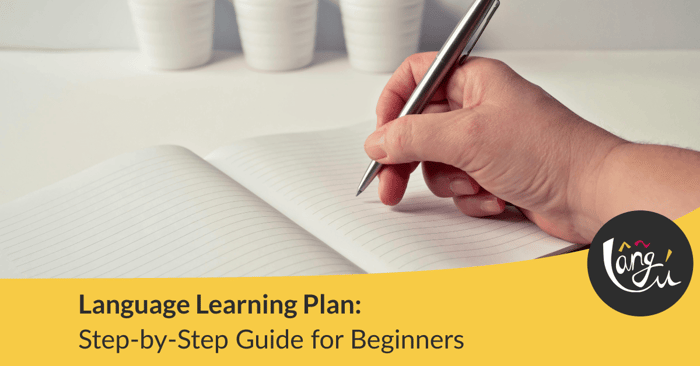Table of Contents
- Step 1 – Set a Clear and Measurable Goal
- Step 2 – Choose Your Core Learning Materials
- Step 3 – Build a Consistent Study Routine
- Step 4 – Focus on the Four Key Skills
- Step 5 – Track Progress and Celebrate Wins
- Step 6 – Get Real Speaking Practice (This Is Non-Negotiable)
- Step 7 – Stay Flexible and Adjust Over Time
- Conclusion: Take the First Step Today
- FAQs
Learning a new language can feel overwhelming. You open an app, memorize a few words, then lose motivation a week later. Sound familiar? That’s because learning without a structured approach rarely works. What you need is a clear, realistic language learning plan—one that’s tailored to your goals, time, and lifestyle.
In this guide, you’ll learn exactly how to build a step-by-step language learning plan that keeps you motivated and actually gets results.
Step 1 – Set a Clear and Measurable Goal
Every strong language learning plan starts with purpose. “Learn Spanish” is too vague. “Hold a 10-minute conversation in Spanish within three months” is better. Specific goals give you direction and help you track progress.
How to Define Your Language Goals
Ask yourself:
Why do I want to learn this language?
What do I want to be able to do with it in 3, 6, or 12 months?
How much time can I realistically dedicate each week?
Write your answers down. Your goal will be the backbone of your plan.
Step 2 – Choose Your Core Learning Materials
With endless apps, books, and YouTube videos, it’s easy to fall into a trap of resource overload. Avoid jumping between tools. Instead, pick one or two primary materials and stick with them.
Must-Have Resources for Beginners
App: Duolingo, Babbel, or Memrise for vocabulary basics
Textbook: "Teach Yourself" or "Colloquial" series for grammar
Audio: Podcasts like Coffee Break Languages or Pimsleur
Tutor: More on this below—but a live teacher can fast-track your results
The best language learning plan combines structured resources with real-life usage.
Step 3 – Build a Consistent Study Routine
Consistency beats intensity. It’s better to study 20 minutes a day than 2 hours once a week. Your brain thrives on repetition, and daily exposure helps with retention.
Design Your Weekly Learning Schedule
Here’s a sample beginner-friendly plan:
Monday: 20 mins app + 10 mins listening
Tuesday: 30 mins textbook study
Wednesday: 20 mins vocabulary review + 10 mins writing
Thursday: 30 mins speaking practice
Friday: Watch a short video or TV clip in your target language
Weekend: 1 conversation session with a tutor or language partner
Your language learning plan should feel doable, not exhausting. Adjust as needed, but aim for daily touchpoints.
Step 4 – Focus on the Four Key Skills
A balanced language learning plan covers:
Listening
Speaking
Reading
Writing
Many beginners focus only on reading or listening. Don’t fall into this trap—neglecting speaking and writing will slow your real-world progress.
How to Practice Each Skill
Listening: Watch YouTube or Netflix with subtitles, listen to podcasts
Speaking: Talk out loud, mimic native speakers, join conversation exchanges
Reading: Start with children’s books, news sites, or graded readers
Writing: Keep a daily journal, comment on social media posts, or write emails to yourself
The more you engage with the language in different ways, the deeper it sticks.
Step 5 – Track Progress and Celebrate Wins
Motivation can dip. That’s why tracking your progress is critical. It reminds you how far you’ve come—even when fluency still feels far away.
Progress Tracking Tips
Keep a journal of new words learned each week
Record yourself speaking monthly to hear improvement
Set small weekly goals (e.g. “Learn 20 new words” or “Finish 1 podcast episode”)
Reward yourself when you hit milestones. Finished your first conversation with a native speaker? That’s worth celebrating.
Step 6 – Get Real Speaking Practice (This Is Non-Negotiable)
Reading and listening are safe. Speaking feels uncomfortable. But there’s no getting around it—you must speak to get fluent.
That’s where a professional tutor comes in. A great teacher can correct your mistakes, boost your confidence, and accelerate your learning like nothing else.
There’s no better way to stick to your language learning plan than by scheduling regular speaking sessions with a native speaker.
Step 7 – Stay Flexible and Adjust Over Time
No plan is perfect from the start. Your goals might shift. Your schedule might get messy. That’s okay.
The key is to regularly reflect and revise:
What’s working?
What feels frustrating?
What needs to change?
A strong language learning plan evolves with you. Adapt, don’t abandon.
Conclusion: Take the First Step Today
You don’t need to be a genius or a grammar nerd to learn a language. You just need a smart, realistic plan—and the discipline to stick with it. Start small. Be consistent. Speak often. Adjust as you grow.
And remember: you don’t have to do it alone.
The best way to stick to your language learning plan and gain confidence fast is by working with a professional teacher. Whether you're starting from scratch or brushing up rusty skills, a tutor provides structure, feedback, and motivation.
👉 Ready to take the next step? Book a session with a professional language tutor at Langu and turn your goals into real-world progress.
Create a learning plan with a professional language tutor
FAQs
What is a language learning plan and why do I need one?
A language learning plan is a structured approach to studying a new language. It helps you stay focused, set clear goals, and track your progress effectively.
How do I create a language learning plan that works for my schedule?
To create a language learning plan that fits your lifestyle, set realistic goals, choose reliable resources, and dedicate consistent time each day—even just 20 minutes.
Can a tutor help me stick to my language learning plan?
Yes! A tutor provides structure, accountability, and real-time feedback, making it much easier to follow and stick to your language learning plan over time.




